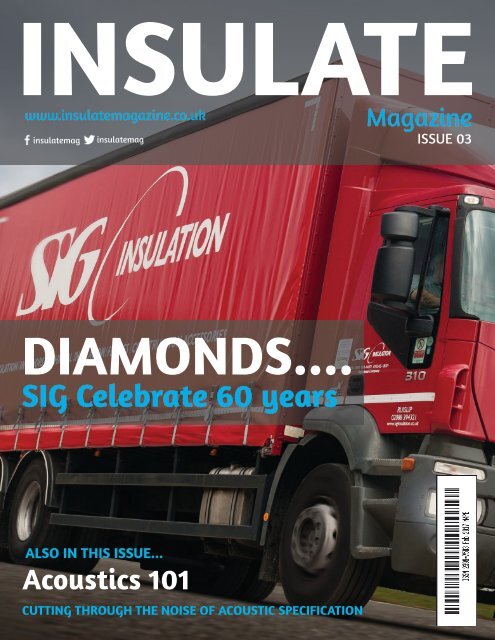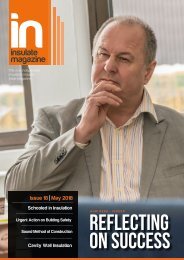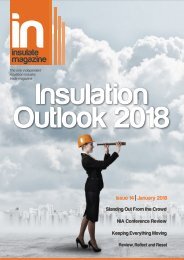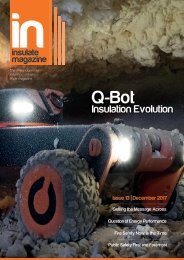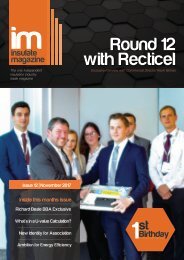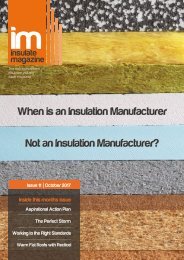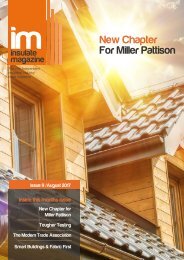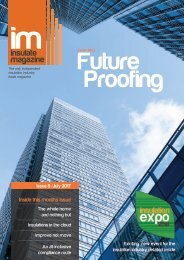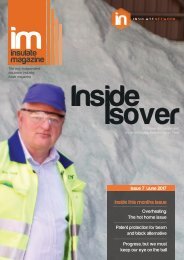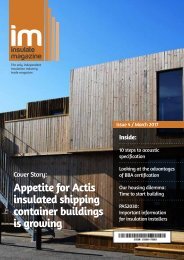Insulate Magazine Issue 3
You also want an ePaper? Increase the reach of your titles
YUMPU automatically turns print PDFs into web optimized ePapers that Google loves.
INSULATE<br />
<strong>Magazine</strong><br />
www.insulatemagazine.co.uk<br />
insulatemag insulatemag<br />
ISSUE 03<br />
DIAMONDS....<br />
SIG Celebrate 60 years<br />
ALSO IN THIS ISSUE...<br />
Acoustics 101<br />
CUTTING THROUGH THE NOISE OF ACOUSTIC SPECIFICATION
Experience,<br />
quality & service<br />
Over 25 years experience in facades<br />
Customer service & quality are<br />
our key objectives<br />
Facade works (SFS, EWI, rainscreen<br />
cladding) undertaken by fully trained<br />
& certified personnel<br />
Experienced personnel, reputation<br />
& quality focused<br />
Approved installer for<br />
reputable systems<br />
Speedy & professional service<br />
25 year insurance-backed<br />
guarantee available<br />
Contact us today!<br />
01788 220023<br />
info@weathersealfacades.co.uk<br />
www.weathersealfacades.co.uk<br />
Company Registration No. 9052005 VAT Reg No. 189 8175 43
INSULATE<br />
<strong>Magazine</strong><br />
60 YEARS OF SIG INSULATION:<br />
Cover Story<br />
ECOBUILD PREVIEW<br />
Event special<br />
INTERVIEW<br />
We talk to BRUFMA CEO<br />
Simon Storer<br />
ACOUSTICS 101<br />
Sound Advice from industry experts<br />
THERMAL BRIDGING<br />
Guest feature from Darren Evans<br />
Assesments<br />
An exclusive publication for the insulation industry<br />
Published on a monthly basis by M4 Publications & Events Ltd<br />
Corser House, 17 Geen End, Whitchurch, Shropshire, SY13 1AD<br />
Call 01948 759 351<br />
Outside of the UK +44 1948 759351<br />
Monday - Friday 9am - 5.30pm<br />
Website: www.insulatemagazine.co.uk<br />
Email: contact@insulatemagazine.co.uk<br />
5<br />
7<br />
10<br />
12<br />
20<br />
with you directly. CLASSIFIED ADVERTISING APPEARS IN PRINT AND ONLINE.<br />
WE ARE NOT RESPONSIBLE FOR ERRORS AFTER PROOFING AND INSERTION.<br />
DISPLAY ADVERTISING.<br />
Contact one of our sales staff to discuss your requirements on 01948 759 351. Publisher<br />
reserves the right to reject any advertising that in its opinion is misleading, unfair<br />
or incompatible with the character of the magazine.<br />
We adhere to the IPSO code of practice for editors. Further information can be found<br />
at www.ipso.org.uk<br />
SUBSCRIPTION INFORMATION<br />
Subscription is free for anyone within the UK and Channel islands. Anyone can<br />
subscribe for free online at www.insulatemagazine.co.uk/subscribe or by phone on<br />
01948 759 351 subscriptions are available around the world free in digital format. Print<br />
subscriptions are available around the world, please call us for a quote. More information<br />
is available on www.insulatemagazine.co.uk<br />
Our subscriber list is occasionally made available to very carefully selected companies<br />
whose products or services may be of interest to you. Your privacy is of paramount<br />
importance to us and should you prefer not to be part of these lists then please email<br />
your details and a short message to contact@insulatemagazine.co.uk<br />
CLASSIFIED ADVERTISING<br />
Rate: No photo classified £25 for 20 words, each additional word costs £1. All classified<br />
advertising must be paid in advance. We must receive your classified advert at<br />
least two weeks prior to the publication date.<br />
WE DO NOT ACCEPT PHONE IN CLASSIFIED ADVERTISING<br />
In the first instance, email your advert to adverts@insulatemagazine.co.uk and await<br />
your invoice, once payment is received our design team will clarify the advert insertion<br />
BACK ISSUES OR REPRINTS<br />
Digital back issues can be foud online at www.insulatemagazine.com For printed editions<br />
please email contact@insulatemagazine.co.uk , there will be a postage charge<br />
and handling fee of £5+VAT for each copy requested.<br />
CIRCULATION<br />
The magazine is sent to 30,000 per month with a print run of 20,000<br />
©M4 PUBLISHING & EVENTS LTD<br />
No part can be reproduced without the express permission of the publisher<br />
Facebook: www.facebook.com/insulatemag<br />
Twitter: www.twitter.com/insulatemag<br />
Youtube: www.youtube.com/insulatemag<br />
LinkedIn: www.linkedin.com/company/insulate-magazine<br />
www.insulatemagazine.co.uk<br />
insulatemag insulatemag
External and Hybrid wall<br />
insulation systems aren’t<br />
always all they’re<br />
cracked up<br />
to be...<br />
That’s why we recommend<br />
Independent Solid Wall Inspections by the experts<br />
All too often, External Wall Insulation (EWI) is installed into<br />
properties without sufficient detailed analysis of the building’s<br />
condition. In some cases, EWI may not even have been<br />
appropriate in the first place. There are a great many<br />
considerations to be addressed before a property can be<br />
declared fit-for-purpose and procedures finally implemented.<br />
But it doesn’t stop there. It’s also important to understand the<br />
ongoing maintenance obligations associated with these<br />
installations, as this affects any long term guarantees that are in<br />
place. A thirty-year guarantee can be invalid if you do not have<br />
a regular maintenance regime in place to inspect building joints,<br />
particularly around window and door frames. Without this kind of<br />
attention to detail, your EWI system guarantor may have a get<br />
out clause should the system fail prematurely.<br />
The BBA can provide you with a reliable, independent regular<br />
inspection service that meets the requirements of your specific<br />
EWI guarantee.<br />
If you decide to progress with BBA inspection, one of our<br />
specialist external wall insulation surveyors will visit your property<br />
to establish its suitability with regard to specific construction<br />
characteristics, details of pipework, external fittings, organic<br />
growth etc, talking you through each step of the process.<br />
The key issue often associated with external wall insulation is<br />
damp. If you already have a problem with this, it will need to be<br />
rectified before the insulation is installed, otherwise you run the<br />
risk of trapping the damp inside the wall structure and making<br />
the situation worse.<br />
It’s also important to make sure that the new external insulation<br />
layer and cladding do not bridge the damp proof layer in the<br />
wall. The insulation should start above this, otherwise water may<br />
be able to use it to rise above the damp proof membrane,<br />
causing rising damp where it wasn’t a problem before. Our BBA<br />
specialists will identify whether or not if this is the case prior to<br />
recommending any further works.<br />
We can also step in and assess your properties at a later stage,<br />
helping you to find a remedy to any existing failed installations.<br />
Our expert advice and opinion may also be of value in your<br />
legal proceedings.<br />
50 years of unrivalled expertise in building and construction<br />
certification means the BBA is quite simply the best possible<br />
stamp of approval you can get. So when it comes to<br />
independent assessment of the solid wall insulation, you can<br />
count on the BBA. We are an independent body, fully accredited<br />
by the United Kingdom Accreditation Service (UKAS), and as<br />
such our technical assessors have the expertise to ensure the UK’s<br />
Local authorities and Housing Associations avoid potential<br />
difficulties associated with External Wall Insulation.<br />
To guarantee the best approach to insulation installation,<br />
from start to finish and beyond,<br />
contact the BBA today.<br />
clientservices@bba.star.co.uk<br />
www.bbacerts.co.uk<br />
01923 665300
Cover Story<br />
The last 60 years have seen some monumental changes come to pass in the construction industry, but 2017 also<br />
marks 60 years of excellent, continuous service from SIG Insulation, the UK’s market leading specialist distributor of<br />
insulation.<br />
Founded in 1957 by Ernest Adsetts as Sheffield Insulation, the company operated from a single site and a converted<br />
ice-cream van, but grew rapidly in the coming decades.<br />
Over the years SIG expanded into a wider group, becoming a leading distributor of specialist building products<br />
throughout Europe and provides everything from flooring to roofing products. However insulation remains at the<br />
heart of its offering, and the company now has more than 30 specialist insulation branches from Inverness to Plymouth.<br />
These many years of experience in working with insulation provide the company with a unique insight into the<br />
selection and specification of an exceptional range of products. Nearly 1,200 staff are on hand to meet its customers’<br />
needs, with 2,400 distinct structural insulants being distributed to more than 10,000 customers in 2015 alone.<br />
Speaking on the diamond anniversary, David Hope – Sales & Marketing Director at SIG Distribution said: “It’s a<br />
great honour to celebrate 60 years of trading for SIG Insulation. A number of elements have contributed to our longevity,<br />
including our loyal customers and the hard work of our staff over the decades.<br />
“As one of the largest employers in the Yorkshire region, and with many more staff throughout the UK, we’re proud<br />
to have provided a rewarding place for so many people to work for so many years. Some employees have served the<br />
company for more than 40 years so far, and I’d like to thank each of them personally.<br />
“We also believe that it’s the duty of large companies to give back to their communities, and SIG Insulation is no different,<br />
supporting charities and initiatives including The Children’s Hospital Charity Sheffield, Macmillan and Race<br />
for Life. This is something that we’ll continue to do as the company expands further, and SIG look forward to the<br />
next 60 years.”<br />
To find out more about SIG Insulation, visit: http://www.siginsulation.co.uk/
@ecobuild_now #ecobuild<br />
/ecobuildnow<br />
Ecobuild is evolving with the industry,<br />
focusing on the issues that matter the most.<br />
Register for a free ticket: www.ecobuild.co.uk<br />
Strategic Partners:
The Insulation Industry Trade <strong>Magazine</strong><br />
INSULATE<br />
I<br />
Ecobuild’s Regeneration Return<br />
Ecobuild returns on<br />
7-9 March with an<br />
overarching theme<br />
of regeneration. The<br />
event will provide a unique<br />
opportunity for insulation<br />
professionals to join the<br />
construction industry’s<br />
ongoing debates around<br />
key issues, as well as the<br />
chance to network with<br />
hundreds of sector experts<br />
and suppliers including<br />
Hitachi, Oventrop, Celotex,<br />
Recticel, Xtratherm, Reflex,<br />
Altecnic and many more.<br />
This year’s show will see<br />
ExCeL London transformed<br />
into a ‘city’ – complete<br />
with a main street, distinct<br />
destinations and special<br />
feature attractions. As visitors<br />
make their way through<br />
the space, they will be<br />
introduced to key destinations<br />
including The Arena,<br />
City Hall, The Campus, The<br />
Gateway and The Performance<br />
Lab.<br />
City Hall<br />
Sponsored by Saint-<br />
Gobain, City Hall will be the<br />
show’s sustainability hub<br />
and home to the UK Green<br />
Building Council (UK-GBC).<br />
City Hall represents the<br />
culmination of Ecobuild’s<br />
‘Redefining Sustainability’<br />
campaign to create an industry-wide<br />
understanding<br />
of sustainability objectives<br />
and drivers, with a clear<br />
direction for the future.<br />
Key issues covered in the<br />
‘Redefining Sustainability’<br />
seminar programme, will<br />
include carbon reduction<br />
in the built environment,<br />
explored in a session by the<br />
UK-GBC, as well as possible<br />
approaches to deliver<br />
a low carbon city or neighbourhood.<br />
www.insulatemagazine.co.uk
I<br />
<strong>Insulate</strong> <strong>Magazine</strong><br />
The Gateway<br />
The Gateway is where visitors can explore<br />
national and community-level<br />
infrastructure projects, as well as a separate<br />
seminar theatre dedicated to green<br />
infrastructure.<br />
The ‘Green Infrastructure’ seminar sessions<br />
will discuss the various elements of<br />
an integrated approach combining green<br />
(natural), blue (water) and grey (engineered)<br />
infrastructure, to combat the negative<br />
effects of climate change and build<br />
long-term urban resilience.<br />
The Performance Lab<br />
In association with the Chartered Institute<br />
of Building Services Engineers (CIBSE),<br />
The Performance Labwill showcase the<br />
latest in energy efficiency and building<br />
performance.<br />
Across the three days, CIBSE will also<br />
host a daily session on indoor health and<br />
wellbeing, exploring how the WELL Standard<br />
relates to existing sustainability standards<br />
such as BREEAM and LEED.<br />
Focus on Distric Energy<br />
Ecobuild 2017 will also give insulation professionals<br />
access to a special showcase<br />
on district energy, the result of a brand new<br />
partnership between Ecobuild and the UK<br />
District Energy Association (ukDEA).<br />
The ukDEA District Energy Town Square<br />
will act as a focal point for visitors who<br />
want to learn about the advantages of local<br />
heating and cooling networks. Reflecting<br />
growing interest in this topic, each day<br />
of the show will focus on a different sector,<br />
ranging from private and public sector<br />
housing developers to universities and<br />
campus-style networks.<br />
For Insulation Professionals
The Insulation Industry Trade <strong>Magazine</strong><br />
INSULATE<br />
I<br />
The Arena<br />
The Arena will be home to the Ecobuild<br />
Conference, sponsored by Skanska, staging<br />
a range of keynote speeches from<br />
industry thought leaders and innovators<br />
across the three days.<br />
Day one of the conference programme<br />
will feature sessions exploring how the<br />
industry can best deliver high quality,<br />
sustainable and affordable homes while<br />
seamlessly integrating them into existing<br />
communities. It will also include a debate<br />
on the benefits of offsite construction. Key<br />
speakers on the day will include Lord Kerslake;<br />
Professor Tim Broyd, President at<br />
ICE, and Paul Westbury, Group Technical<br />
Director at Laing O’Rourke.<br />
Sessions on the second day will include<br />
an industry leaders’ debate on the solutions<br />
to the housing crisis, featuring a<br />
panel including Jules Pipe, Deputy Mayor,<br />
Planning Regeneration and Skills, Greater<br />
London Authority.<br />
Highlights on the third day include a discussion<br />
on challenges and opportunities<br />
for construction in the UK in light of Brexit,<br />
particularly evaluating how this will impact<br />
construction products and construction<br />
design and methodology.<br />
Free registration is now open for<br />
visitors. For more information on this<br />
year’s event, exhibitors and conference<br />
visit www.ecobuild.co.uk<br />
www.insulatemagazine.co.uk
The <strong>Insulate</strong> <strong>Magazine</strong> team caught up with<br />
new British Urethane Foam Manufacturers<br />
Association (BRUFMA) CEO,<br />
Simon Storer for a brief interview about his<br />
new role.<br />
Hi Simon, firstly, congratulations on the new role,<br />
what was the draw to the insulation industry?<br />
Thank you for having me, the draw for me was that<br />
I had knowledge of the insulation sector from my<br />
time in construction, I see the importance of insulation<br />
in assisting in the UK reaching its 2050 climate<br />
targets and the role of BRUFMA and the companies<br />
that we represent having a huge benefit on the<br />
housing stock in the UK and on the built environment<br />
in general.<br />
You mention a background in construction; can you<br />
tell us more about that?<br />
I’ve spent most of my career in construction, I spent<br />
eight years in construction manufacturing, moving<br />
into infrastructure in 1985 working on the Channel<br />
Tunnel. In 1995 I delivered the Faraday lecture<br />
to 100,000 people directly along with a further<br />
two million on television, I then worked alongside<br />
Levitt Bernstein as communications consultant for<br />
the Holly St development in London. I then spent<br />
eight years at the Construction Products Association<br />
(CPA).<br />
For readers who may have never heard of BRUFMA,<br />
what does the organisation do?<br />
We represent all UK manufacturers in the PIR/PUR<br />
insulation market, which represents 50% of the<br />
insulation market as a whole, we act as a conduit of<br />
information which enables us to both lead and follow<br />
the experts within the organisations we represent,<br />
which in turn benefits specifiers and end users<br />
alike.<br />
our members have the highest technical knowledge<br />
of the sector and we intend to capitalise on that to<br />
position BRUFMA as part of the fabric of the<br />
industry.<br />
Sounds Great, so much more presence and a voice for<br />
the members?<br />
Absolutely!<br />
We’ve recently received the Bonfield review, how do<br />
you see it having impact on the industry?<br />
As an organisation, we welcome the review, but we<br />
now have to see how Peter Bonfield’s recommendations<br />
are implemented and what we can all do<br />
to make this happen. The key progress will be to<br />
move from proposals to implementation. It’s clear<br />
that preparation, measurement and assessment will<br />
be critical, so let’s hope the government is serious<br />
about bringing the built environment and especially<br />
the housing stock up to a higher standard of energy<br />
efficiency. We have the ability and the products to<br />
achieve this, the issue now is about how it can be<br />
delivered, how it will be paid for and to maintain<br />
the confidence of the end user.<br />
You’ve kindly offered to contribute a monthly column<br />
to <strong>Insulate</strong> <strong>Magazine</strong>, what can our readers expect?<br />
More comment on the issues we’ve discussed today<br />
along with a balanced look at the industry as we<br />
continue to grow.<br />
We really appreciate you talking to us and good look<br />
in your new role.<br />
We understand we will be hearing much more from<br />
BRUFMA in the coming months, what are the plans?<br />
We are looking to expand our access and get a seat<br />
at the table when it comes to legislation and regulation<br />
within the insulation industry,
The Insulation Industry Trade <strong>Magazine</strong><br />
NIA highlights new<br />
PAS2030 for Insulation<br />
Projects and Reasons to<br />
Choose NIA Members<br />
The National Insulation Association (NIA)<br />
is advising specifiers and industry of the<br />
new revised PAS2030 which will be published<br />
at the end of January and will govern<br />
the national standards that installers<br />
must work to in the installation of energy<br />
efficiency measures.<br />
The new PAS2030 will be more comprehensive<br />
and robust than the current one<br />
and include the following additional items:<br />
The initial assessment of properties for<br />
suitability to receive the measures.<br />
The system design and design detailing.<br />
Specific industry standards and specifications<br />
setting out the standards all installers<br />
must work to such as the new NIA Specification<br />
for installing EWI with fuel burning<br />
appliances, Room in Roof Insulation survey<br />
form and best practice guide and loft<br />
insulation specification.<br />
Stricter competency ratios (number of<br />
trained operatives) per site.<br />
All sub-contractors will need to be<br />
PAS2030 accredited as well as the main<br />
contractor.<br />
Neil Marshall Chief Executive of the NIA<br />
commented: “Whilst the improvements to<br />
PAS2030 are welcomed, they will only be<br />
as effective as the strength of the policing<br />
and enforcement by the PAS2030 Certification<br />
Bodies. “Therefore the NIA is adding<br />
the requirement for our members to adhere<br />
INSULATE<br />
strictly to the new PAS2030 to our rules of<br />
membership. If we then receive reports/<br />
complaints from householders or<br />
specifiers of insulation works that an NIA<br />
installer member is not complying with<br />
PAS2030 we will investigate this and take<br />
strong disciplinary action which can include<br />
suspension or expulsion if a breech is<br />
found.<br />
“We would therefore urge householders<br />
and specifiers of insulation works including<br />
Local Authorities, Housing Associations,<br />
Energy Companies, Builders and Architects<br />
to choose NIA members to carry out<br />
work and incorporate a requirement for<br />
NIA membership in their future tenders for<br />
insulation projects as this will provide an<br />
additional level of assurance, enforcement<br />
and recourse.<br />
“To help specifiers in this regard we have<br />
introduced a new ‘Expressions of Interest<br />
and Tender Request’ Service whereby if<br />
specifiers provide us with details of projects<br />
and specifications we will circulate<br />
these to our members saving specifiers<br />
time and money.”<br />
Specifiers interested in<br />
the service should contact<br />
Bev Hodson at the<br />
NIA bev.hodson@nia-uk.<br />
org or call 01525 383313<br />
I<br />
www.insulatemagazine.co.uk
I<br />
<strong>Insulate</strong> <strong>Magazine</strong><br />
Safe from Sound –<br />
Overcoming the Conflicting<br />
Requirements for Thermal<br />
and Acoustic Insulation<br />
City populations are continuing to grow, with ONS research suggesting that areas<br />
such as London’s Tower Hamlets could be home to 25% more residents in 2024<br />
than in 2016. As a result of this, developers are increasingly looking to the use of<br />
large-scale apartment buildings to meet demand in urban areas.<br />
However, creating new homes in urban areas means that noise levels within apartments<br />
must be considered and balanced with providing high quality thermal insulation, with<br />
both qualities required in order to maximise resident comfort.<br />
This has been recognised by the imposition of the Building Regulations’ Approved<br />
Document L, Conservation of Fuel and Power, (ADL) and Approved Document Part E,<br />
Resistance to the Passage of Sound, (ADE).<br />
The Challenge<br />
The challenge for designers is that the requirements laid out in the approved documents<br />
must be met in the construction of all new properties, but ADL and ADE’s requirements<br />
can be seen as contradictory, making it difficult to achieve one without having a negative<br />
impact on the other.<br />
For Insulation Professionals<br />
One of the key causes of this contradiction is the use of the Standard Assessment<br />
Procedure (SAP) as a means of identifying a dwelling’s thermal performance under Part<br />
L of the Building Regulations. Often, project designers work with SAP to identify the most<br />
thermally efficient wall construction method, with lightweight blocks and PIR insulation<br />
boards being particularly effective for both external and party walls, creating a consistent<br />
design.<br />
However, many acoustic specialists recommend the use of different materials to reduce<br />
the travel of sound, opting to specify medium or dense blocks to combat low frequency<br />
sound waves and mineral wool to attenuate high frequency waves, with the two being<br />
used together to provide the best results.
The Insulation Industry Trade <strong>Magazine</strong><br />
INSULATE<br />
I<br />
While these two approaches should be complimentary, especially considering that both<br />
ADL and ADE should be met for all new residential developments, this simply isn’t the<br />
case. Taking the thermally efficient approach laid out by SAP can lead to a failure tomeet<br />
ADE, and vice versa.<br />
Fortunately, There is a Solution<br />
The Robust Details® scheme serves as an alternative to carrying out pre-completion<br />
sound testing as a means of meeting Approved Document E requirements. In essence,<br />
the Robust Details® handbook provides a list of pre-approved construction types, which<br />
can not only meet ADE, but that will also satisfy ADL provided suitable care is taken.<br />
Striking the balance between meeting ADE and ADL requirements can be complex, even<br />
when using Robust Details® guidance. This can be greatly simplified by working with<br />
specialists who have in-depth knowledge of this field, and in particular those which work<br />
with the two areas simultaneously, such as SIG360.<br />
Work With The Experts<br />
In addition, working with experts can also allow compromises to be made in the<br />
wall specification by examining cold bridging details and working with psi values to calculate<br />
heat loss from each junction, for instance between walls, floors and roofs which could<br />
provide a cost effective compromise in the solutions available. Similarly, fire-stopping<br />
measures such as fire socks and barriers must be considered for compliance with Part B<br />
of the Building regulations.<br />
By working with specialist technical experts, specifiers, developers and architects<br />
can have the best of both worlds, providing future residents with a space that is<br />
not only thermally efficient and cost-effective in terms of energy bills by meeting<br />
ADL, but which also provides a comfortable, quiet living space in accordance with<br />
ADE.<br />
www.insulatemagazine.co.uk
SOUND REDUCTION<br />
Superior sound insulation helps reduce unwanted<br />
noise from both internal and external sources.<br />
THERMAL PERFORMANCE<br />
Stone wool insulation doesn’t just keep buildings warm<br />
today, it maintains its insulating properties for years to come.<br />
© 2016 ROCKWOOL Ltd. All rights reserved.<br />
DIMENSIONAL STABILITY<br />
Density, volume and structural integrity provide<br />
a perfect fit for maintaining performance.
This is ROCK, re-engineered<br />
for a fast, easy and perfect fit.<br />
From volcanic rock to high performance building insulation. See<br />
ROCK re-engineered to provide high performance insulation solutions<br />
for today’s building projects. ROCKWOOL insulation is easy to use,<br />
dense, durable and performs because of its origins in natural stone.<br />
Discover how the transformation happens, and why ROCKWOOL<br />
insulation performs consistently across so many applications.<br />
SEARCH ROCKWOOL INSULATION ORIGINS
I<br />
www.insulatemagazine.co.uk<br />
BIM ready becomes BIM steady<br />
Over the last ten years or so, the building and construction industry, like virtually<br />
everybody else, has been enjoying all the technical advancements of a<br />
digital age. A big part of that has been the introduction of BIM (Building Information<br />
Modelling) and the considerable benefits to architects and specifiers<br />
of the virtual world that has been created to make product selection infinitely quicker and<br />
easier. Manufacturers, too, see the advantages of placing their products in BIM models<br />
for easy selection by their potential customers<br />
Over Populated<br />
However, as with the emergence of many things new and fancy, it can all get a bit out<br />
of hand. BIM libraries are cropping up all over the place and the competition for product<br />
selection is spiralling. What was once a breath of fresh air has, for some specifiers, become<br />
polluted with degrees of uncertainty with regard to correct or reliable product detail<br />
specifications. That’s when the specifier/architect becomes frustrated, and with good<br />
reason, because having found what they want at the BIM library, they later discover that<br />
the details on the virtual object do not match up with its real life counterpart. Moreover,<br />
the more BIM repositories expand as a major source of product selection, the more the<br />
selection process becomes a source of exasperation.<br />
BBA BIM Solution<br />
So, as with anything that gets a little shaky, a little discipline needs to be applied, and<br />
the good news is the British Board of Agrément (BBA) have decided to do something<br />
to help. Rumour has it that the UK’s leading construction products certification body is<br />
getting ready to launch a new certification service to regulate BIM objects for easy and<br />
reliable selection, bringing a source of relief to manufacturers and making life easier for<br />
specifiers.<br />
Industry Know How<br />
It’s the kind of thing the BBA are used to. After all, they’ve been around a long time and<br />
are custodians of good detail, so matching the spec on BIM products against their real<br />
life counterpart should be right up their virtual street. This new service could be a<br />
welcome solution to a frustrating issue that has been spoiling an otherwise successful<br />
and highly useful development in modern building technology. That’s good news for<br />
everyone involved in the process, from architects and specifiers to manufacturers and<br />
customers.<br />
<strong>Insulate</strong> <strong>Magazine</strong> <strong>Issue</strong> 1
The<br />
National<br />
Insulation<br />
Industry<br />
Awards<br />
2017<br />
www.insulationawards.co.uk
27th June<br />
Great Hall<br />
Birmingham<br />
7pm<br />
Entry Now Open<br />
www.insulationawards.co.uk
The National Insulation Industry Awards (NIIA) has announced<br />
that Lord Deben, Chairman of the Committee<br />
on Climate Change is be on its judging panel and that he<br />
will also be addressing the event.<br />
Colin Heath, M4 Publishing & Events Managing Director<br />
commented: “We are extremely lucky and delighted that<br />
Lord Deben is to provide his wealth of experience to the<br />
awards judging panel and we are looking forward to his<br />
speech at our awards which is the insulation industry’s<br />
largest stand-alone event of the year.<br />
Lord Deben, Chairman of the Committee on Climate<br />
Change, said: “I’m very pleased to be joining the National<br />
Insulation Industry Awards judging panel. Heating and hot<br />
water account for around 20% of the UK’s greenhouse<br />
gas emissions. How we go about insulating our homes<br />
and offices is absolutely crucial to reducing those emissions.<br />
I look forward to seeing some truly innovative insulation<br />
solutions to help drive up UK energy efficiency.”<br />
The prestigious awards will be taking place at the Great<br />
Hall in Birmingham on Tuesday June 27th with Grand<br />
Designs Presenter Kevin McCloud as host. A total of 15<br />
awards will showcase the diverse range of talents within<br />
the industry from manufacturers to installers and from<br />
system designers to apprentices.<br />
The Awards are now open, are free to enter www.insulationawards.co.uk/entry<br />
and have a closing date of 20th<br />
March with the shortlist being announced on April 3rd.<br />
For further information on the awards and how to enter<br />
visit www.insulationawards.co.uk/ or contact<br />
Claire Harries on:<br />
T: +44 (0) 1948 759 351<br />
E: claire@m4pe.co.uk<br />
Next Month<br />
Design objective<br />
solutions<br />
BIM<br />
Energy efficiency<br />
everywhere<br />
Material’s world
I<br />
<strong>Insulate</strong> <strong>Magazine</strong><br />
Understanding Thermal Bridging<br />
Thermal bridges are localised areas in the thermal envelope of a building where<br />
there is increased heat loss. A building envelope will have 2 types of thermal<br />
bridge:<br />
Repeating thermal bridges<br />
Repeating thermal bridges are accounted for in the calculation of a buildings U-<br />
values (U-values measure how effective a material is an insulator). Any material that<br />
penetrates the insulation repeatedly and predictably in a heat loss element would be<br />
classed as a repeating thermal bridge. Examples of this type of repeating thermal<br />
bridge are mortar joints in a masonry wall or timber studs in a timber framed construction.<br />
The increased heat loss from these materials is incorporated into the U-<br />
value calculation through bridging factors.<br />
For Insulation Professionals<br />
Non-repeating thermal bridges<br />
Non-repeating thermal bridges occur where building elements meet i.e. walls / floors<br />
or walls / roof and around windows. Psi (Ψ)-values (pronounced ‘si’) are the numerical<br />
value used to measure the amount of heat loss from these junctions.
The Insulation Industry Trade <strong>Magazine</strong><br />
INSULATE<br />
I<br />
The Effect of Thermal Bridging<br />
Over recent years the effect of heat loss through non-repeating thermal junctions on the<br />
performance of a building in complying with Part L has become more and more pronounced.<br />
It is quite a rare occurrence now to find a Part L1A 2013 SAP Calculation that<br />
has not included an assessment of the buildings thermal bridging lengths. Recent research<br />
suggests now that as buildings are better insulated that up to 30% of a buildings<br />
heat loss can come through its non-repeating thermal junctions.<br />
The Growing<br />
Availability of<br />
Calculated PSI Values<br />
Many building material and insulation providers have now calculated their own set of psi<br />
values for customers to use.<br />
These calculated psi values are becoming a differentiating factor within the construction<br />
industry. Buildings that are able to qualify for the use of these calculated psi values will<br />
find enhanced thermal performance in the completion of the SAP Calculation which will<br />
ease compliance with Part L.<br />
Non-Traditional Construction Methods<br />
Although there has been a growing awareness of the importance and impact of thermal<br />
bridges on the performance of a SAP Calculation, there are still some parts of the<br />
construction industry that this information has yet to reach. Any building project where<br />
calculated psi values are not available for use will see an increase in heat loss through<br />
non-repeating junctions of their building and there will be a noticeable decrease in the<br />
thermal performance of the SAP Calculation, leading to additional spend and specification<br />
elsewhere to compensate for this loss.<br />
www.insulatemagazine.co.uk
I<br />
<strong>Insulate</strong> <strong>Magazine</strong><br />
Well Well Well<br />
There has been a lot of talk over the past decade about the energy efficiency of our<br />
buildings. More recently the conversation has shifted to start to include the impact that<br />
buildings are having on our health. One of the other values that is calculated with every<br />
psi value is the surface temperature factor. This value is used to assess the risk of<br />
mould growth through these parts of the building. Moulds produce allergens, irritants and<br />
even toxic substances and can cause asthma attacks and other respiratory illnesses.<br />
Small Gains<br />
For Insulation Professionals<br />
The calculation and use of psi values is now something that every construction project<br />
should incorporate. A calculated psi value is not project specific but related to the<br />
construction method and so can be used repeatedly of subsequent projects whether<br />
the same construction specification is used. This makes the calculation of psi values a<br />
very cost effective solution to energy conservation and energy efficiency. Through using<br />
calculated psi values the heat loss of a building can be more accurately illustrated which<br />
will help SAP Calculations comply more readily with Part L. This will save money from<br />
being invested in other aspects of the building which would be needed to compensate<br />
for the poor thermal performance at the buildings thermal junctions.<br />
As experts in sustainability and energy efficiency we can help you to achieve enhanced<br />
thermal performance and carry out your SAP Calculations which will ease compliance<br />
with Part L Regulations. Wellbeing is a huge consideration for us and we will help you<br />
ensure your building is not only efficient but also a healthier place to be.<br />
Written by Michael Brogden, Technical Director,<br />
Darren Evans Assessments www.darren-evans.co.uk
Insulation<br />
Our latest arrivals have landed...<br />
...offering you 4 new lower lambda<br />
products to choose from<br />
Kingspan Kooltherm ® K103 Floorboard, K110 and K110 PLUS Soffit Board,<br />
and K118 <strong>Insulate</strong>d Plasterboard feature an advanced, fibre-free insulation<br />
core, enabling them to achieve an outstanding thermal conductivity of<br />
0.018 W/m . K. As a result, the products can enable buildings to be built to<br />
the upper levels of fabric performance with minimal thickness.<br />
Further information on the Kingspan<br />
range is available on:<br />
+44 (0) 1544 387 384<br />
literature@kingspaninsulation.co.uk<br />
www.kingspaninsulation.co.uk<br />
Pembridge, Leominster, Herefordshire HR6 9LA, UK<br />
www.kingspaninsulation.co.uk/lowerlambda<br />
®<br />
Kingspan, Kooltherm and the Lion Device are Registered Trademarks of<br />
the Kingspan Group plc in the UK and other countries. All rights reserved.
I<br />
<strong>Insulate</strong> <strong>Magazine</strong><br />
10 Steps to Acoustic Specification<br />
(Part one)<br />
What is the Definition of ‘Noise’?<br />
It is simply unwanted sound and more often than not it will not only be an irritation but<br />
also a health and safety issue. If you are considering the specification of an acoustic<br />
material, then chances are you have a ‘noise’ problem. In the first in a series of blogs,<br />
Mike Carrick AMIOA, Head of Acoustics at Siderise Group, examines the source and the<br />
receiver, the first two steps to acoustic specification to mitigate against noise.<br />
Step 1 - Understand the Source<br />
Whatever the source is, it will have a noise level,so the first thing to do is to ascertain<br />
that level, either by field instruments using a sound level meter or by manufacturers’<br />
data if the source is a machine or similar. Ideally the data should be presented in Octave<br />
Bands or 1/3rd Octave Bands. Otherwise a single numerical value in dB(A), which will<br />
refer to either Sound Power (LW) or Sound Pressure (LP).<br />
How does the source emit the sound energy? Is it airborne sound, structure-borne sound<br />
or a combination of both? Voices are generally airborne while a hammer hitting an object<br />
is generally impact/structure borne. A pump or speaker will generally be both airborne<br />
and structure borne, caused by vibrations transmitting through a rigid material. Whatever<br />
the source, the percentage attributed to each method will vary.<br />
Step 2 - Understand the Receiver<br />
The receiver is quite simply the person or persons who hears the noise and<br />
finds it unacceptable.<br />
For Insulation Professionals<br />
In some instances, the remedial action would be to reduce the noise at source either by<br />
turning the volume down on a radio, or enclose the source with sound insulating materials.<br />
For example a pump could be mounted on rubber anti-vibration mats and enclosed<br />
with a combination of high mass and sound absorbent linings. Sometimes this is not possible<br />
due to the size of source and the practicality, as well as the need to feed the source<br />
with air or material etc.<br />
If reducing noise at source is not possible, then it may be possible to insulate the receiver.<br />
A good example of this would be an acoustic control room in a noisy factory. This<br />
is where the workers are in a relatively small insulated room, or noise haven, inside a<br />
larger factory, providing protection from the harsh noise of machinery.<br />
In my next blog, I’ll look at identifying the sound path and consider how sound energy<br />
travels from the source to the receiver. I’ll also lift the lid on acoustic terminology and<br />
bring some light to this dark art.<br />
For further information about SIDERISE or for specific technical advice visit:<br />
www.siderise.com, email technical@siderise.com, or call 01656 730833
SIG360 work with us<br />
on site, to ensure we<br />
not only meet our<br />
client’s needs but<br />
exceed them.<br />
NEIL HARRISON<br />
HARRISON PROJECTS<br />
AN SIG CUSTOMER<br />
BUILD YOUR NAME ON US<br />
Providing impartial<br />
product advice<br />
The SIG360 Technical Centre is a service offering from SIG, that focuses on helping customers<br />
deliver energy efficient buildings.<br />
Through an intimate knowledge of building regulations and product performance, brought<br />
about through more than 50 years specialising in the energy efficiency of the fabric of a<br />
building, the SIG360 Technical Centre is able to make cost effective and impartial product<br />
selection to ensure the best energy performance can be achieved.<br />
The service provided includes energy statements, U value calculations , condensation risk<br />
analysis, thermal modelling and SAP assessments leading to EPC certification.<br />
If you are seeking impartial advice on the fabric energy efficiency of your building contact<br />
SIG360 Technical Centre.<br />
For guidance you can trust call 0844 443 0059<br />
email 360enquiries@sigplc.com or visit www.sig360.co.uk<br />
Talk to the SIG360 Technical<br />
Centre at the start of your project<br />
for a 360 o view of cost effective<br />
and energy efficient home building


